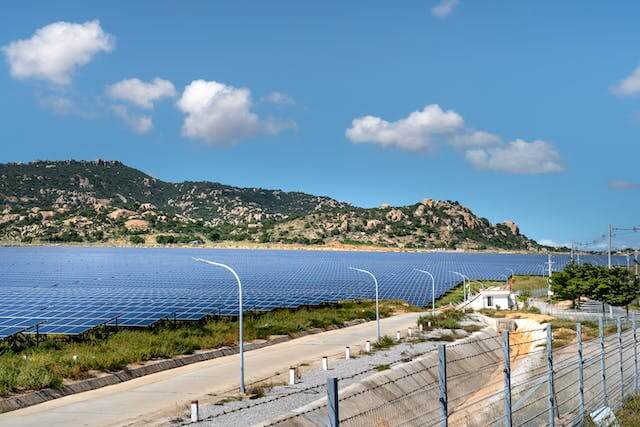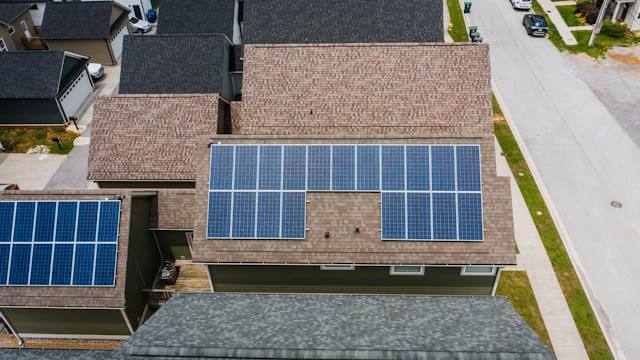Last updated on March 6th, 2025 at 03:56 am
Investing in solar panels is not only a sustainable choice but also a financial one. Understanding the solar panel ROI is crucial for individuals and businesses looking to make informed decisions about harnessing solar energy.
After reading this article, you will gain a comprehensive understanding of solar panel Return on Investment (ROI), covering the intricacies of its calculation and effective strategies to maximize your returns.
2. Installation cost, solar panel lifespan and your total savings during the solar panel lifespan is the most important factor to calculate ROI.
3. Average solar panel ROI in the United States is 177.3% of the upfront cost.
4. In the case of a negative ROI, you would experience a financial loss from your solar panel system, indicating that the investment may not be financially beneficial.
Solar Panel Return on Investment (ROI) Calculator
(*) Required field
Number of solar panels needed*:
If you don't know the number of solar panels you need, Click here to calculate.
Wattage of the solar panels (in Watt)*:
Cost of solar panels per watt (in USD)*:
Click here to convert your native currency to USD.
What is solar panel ROI (Return On Investment)?
Solar Panel ROI, or Return on Investment, is a financial metric that assesses the profitability of a solar energy system after the payback period.
The payback period for solar panels refers to the duration required for the total energy cost savings generated by the solar system to equal the initial investment.
Solar panel ROI is calculated after the payback period. After the payback period, electricity produced by the solar panel system is considered a net gain. Solar panel ROI is calculated in terms of a percentage (%) and is determined with respect to the initial installation cost of the solar panel system.

Importance of solar panel ROI
Understanding the importance of solar panel ROI is crucial for individuals and businesses alike. There are several reason to consider the solar panel ROI:
Financial Decision Making
ROI provides a clear picture of the economic viability of a solar power project. It aids in making informed financial decisions by evaluating the potential returns against the initial investment.
Comparison with Other Investments
ROI enables individuals and businesses to compare the returns from solar power investments with other financial instruments. This comparison aids in allocating resources effectively and maximizing overall financial performance.
Informed Budgeting and Planning
Considering ROI is integral to budgeting and long-term financial planning. It provides a foundation for forecasting future savings and understanding the economic impact of integrating solar power into energy portfolios.
Long-Term Cost Reduction
ROI highlights the long-term cost reduction potential of solar power. Beyond the initial investment, the ongoing savings in energy costs contribute to sustainable financial gains over the operational life of the solar panels.
Attracting Investment and Financing
ROI is a key metric that attracts potential investors and financial institutions. A positive ROI enhances the attractiveness of solar projects, facilitating easier access to funding and support.
Environmental and Social Responsibility
While ROI focuses on financial aspects, considering the environmental and social benefits of solar power is also vital. The integration of ROI ensures a balanced approach that aligns economic objectives with sustainability goals.
How Do Solar Panels Save You Money?
Solar panels contribute to substantial cost savings in various ways, making them a financially attractive investment for homeowners and businesses. Here’s a breakdown of how solar panels can save you money:
Energy Cost Reduction
Solar panels convert sunlight into electricity through photovoltaic cells. By generating your own power, you decrease reliance on electricity supplied by the grid. This leads to a substantial reduction in your monthly electricity bills since you’re meeting a portion of your energy needs with free solar-generated power.
Net Metering
Net metering programs enable you to feed surplus solar-generated electricity back into the grid. When your panels produce more energy than your property consumes, this excess electricity is sent to the grid. In return, you receive credits or compensation from your utility company, effectively offsetting your overall energy costs.
Government Incentives and Rebates
Many governments incentivize the adoption of solar energy by offering financial benefits. Tax credits, grants, and subsidies are common incentives. These reduce the initial investment required to install solar panels, making the technology more accessible and financially appealing to homeowners and businesses.
Increased Property Value
Homes equipped with solar panels often enjoy an increase in property value. This is due to the added appeal of a property generating its own renewable energy. Potential buyers are attracted to the prospect of lower energy bills, environmental consciousness, and the overall sustainability of the property, making it more desirable in the real estate market.
What are the parameters needed to calculate solar panel ROI?
- Initial installation cost
- Your annual electricity bill
- Solar panel lifespan
How to calculate solar panel ROI? Step-by-step guide
Use the calculator at the beginning to calculate your solar panel ROI.
The formula to calculate solar panel ROI is:
Solar panel ROI=[Net profit /Initial installation cost]×100%
Net profit=(Total savings during the solar panel lifespan-initial installation cost)
Lets breakdown the calculation:
Step 1: Initial installation cost
Suppose the initial installation cost of your solar panel system is $20,000. After considering the 30% federal tax credit, the installation cost will be 0.7×($20,000)=$14,000.
Step 2: Total savings
Let’s imagine the lifespan of your solar panels is 25 years.
And your electricity bill is $120/month.
Then your annual savings are = $120 × 12= $1440
Your total savings during the 25 years of the lifespan of the solar panel is=($1440 ×25)= $36,000.
Step 3: Calculate ROI
Solar panel ROI=[Net profit /Initial installation cost]×100%
Before tax credit:
Before the tax credit, the installation cost of your solar panel system is $20,000.
The net profit after the payback period is= (36,000-20,000)=$16,000.
The ROI of your solar panel system is = [16,000/20,000]×100 %
=80%
After tax credit:
After the tax credit installation cost of your solar panel system is $14,000
The net profit after the payback period is= (36,000-14,000)=$22,000
ROI of your solar panel system is = [22,000/20,000]×100 %
=110%
If you have a solar panel system with an installation cost of $20,000 and a lifespan of 25 years, then the net profit after the payback period is $16,000, and the ROI is 80% of the initial installation cost. However, if you consider the tax credit, then your net profit after the payback period is $22,000, and the ROI is 110% of the initial investment.
Can solar panel ROI be negative?
Yes, solar panel ROI can be negative under certain circumstances. A negative ROI, or Return on Investment, signifies that the financial returns from an investment are insufficient to cover the initial investment cost, resulting in a financial loss.
Negative solar panel ROI (Return on Investment) occurs when the financial returns generated by a solar panel system are insufficient to cover the initial installation cost, resulting in a net loss.
Now, let’s consider an example where the total savings are not sufficient to cover the initial installation cost:
- Initial Installation Cost: $20,000
- Total Savings during the Solar Panel Lifespan: $15,000
Net Profit = $15,000 – $20,000 = -$5,000
Solar Panel ROI = [(-$5,000) / $20,000] × 100% = -25%
In this example, the negative ROI (-25%) indicates that the total savings generated by the solar panel system were not enough to recoup the initial investment. A negative ROI suggests that the financial returns did not justify the upfront cost, and the investment resulted in a financial loss.
Average solar panel ROI in the United States
According to the U.S. Energy Information Administration (EIA) data , the average household in the United States consume 10,791 kilowatt-hours (kWh) of electricity annually at a cost of 16.19 cents per kWh. To fulfil an annual energy demand of 10,791 kilowatt-hours (kWh), a solar panel system of 7.2 kW is needed. Consequently, the annual electricity cost for the average household is approximately (10,791×16.19) or $1747.
According to the Department of Energy, average lifespan of solar panels is about 30-35 years. Over the average lifespan of a solar panel system, set at 30 years, meeting this annual energy demand would require a solar panel system of 7.2 kW.
The installation cost for a 7.2 kW solar panel system is $27,000, and after the tax credit cost is $18,900. The total savings over the system’s 30-year lifespan, considering the annual energy cost is $1747, amount to (1747×30) or $52,410. The net gain, calculated as total savings minus the after-tax installation cost (52,410-18900)= $33,510.
Then the average solar panel ROI in the united states is approximately ($33,510/18,900)×100%=177.3%
Therefore, based on this analysis, the average solar panel ROI in the United States is estimated to be 177%, making solar energy a financially viable and rewarding investment for homeowners.
How to increase your solar panel ROI?
Optimize System Size
To ensure your solar panel system maximizes financial returns, it’s vital to carefully size it according to your energy needs. Conduct a comprehensive assessment of your historical energy consumption, considering seasonal variations and potential changes in demand.
Right-sizing the system prevents underutilization, where an insufficiently sized system may not cover all energy needs, elongating the payback period. Conversely, an appropriately sized system not only meets current energy requirements but also has the potential to produce excess energy, fast-tracking your Return on Investment (ROI).
Select High-Efficiency Panels
Investing in high-efficiency solar panels enhances the overall performance and financial impact of your solar energy system. High-efficiency panels convert more sunlight into electricity, resulting in increased energy production.
This heightened efficiency translates into higher energy savings, which, in turn, improves your ROI. While high-efficiency panels may have a slightly higher upfront cost, the long-term financial benefits make them a strategic choice for maximizing returns on your solar investment.
Take Advantage of Incentives
Exploring and leveraging available government incentives, tax credits, rebates, and grants can significantly influence the financial attractiveness of your solar panel installation.
These incentives act as financial perks, reducing the initial installation cost and accelerating the payback period. By strategically navigating and taking advantage of these opportunities, you can enhance your ROI and make your solar investment more cost-effective.
Utilize Net Metering
Engaging in net metering programs, where permitted, is a valuable strategy for optimizing your solar panel ROI. Excess energy generated by your solar panels can be fed back into the grid, earning you credits or compensation.
Net metering not only contributes to additional savings but also allows you to take advantage of the grid as a virtual storage solution, making your solar investment more financially rewarding over time.
Regular Maintenance and Monitoring
Implementing a proactive maintenance plan for your solar panel system is essential for ensuring optimal performance and preventing potential issues that could impact ROI. Regular cleaning, inspections, and prompt repairs contribute to the longevity of your system, maintaining consistent energy production and preserving the financial benefits over the operational life.
Stay Informed and Upgrade Technology
Keeping abreast of technological advancements in solar panels allows you to make informed decisions about upgrading your system.
Incorporating the latest innovations can improve efficiency, extend the lifespan of your installation, and positively influence your ROI. Staying informed ensures that your solar investment remains at the forefront of technological progress, contributing to long-term financial success.
Conclusions
Solar panel ROI encapsulates the financial viability of investing in renewable energy. A positive ROI, indicating returns exceeding the initial investment, showcases the appeal of solar energy both economically and environmentally.
Factors like installation costs, government incentives, and energy efficiency impact ROI. As technology advances and costs decrease, solar panels become an increasingly attractive and profitable investment, contributing not only to individual financial gains but also to a sustainable and resilient energy future.


